air condition MERCEDES-BENZ GL SUV 2012 Owner's Guide
[x] Cancel search | Manufacturer: MERCEDES-BENZ, Model Year: 2012, Model line: GL SUV, Model: MERCEDES-BENZ GL SUV 2012Pages: 441, PDF Size: 10.66 MB
Page 318 of 441
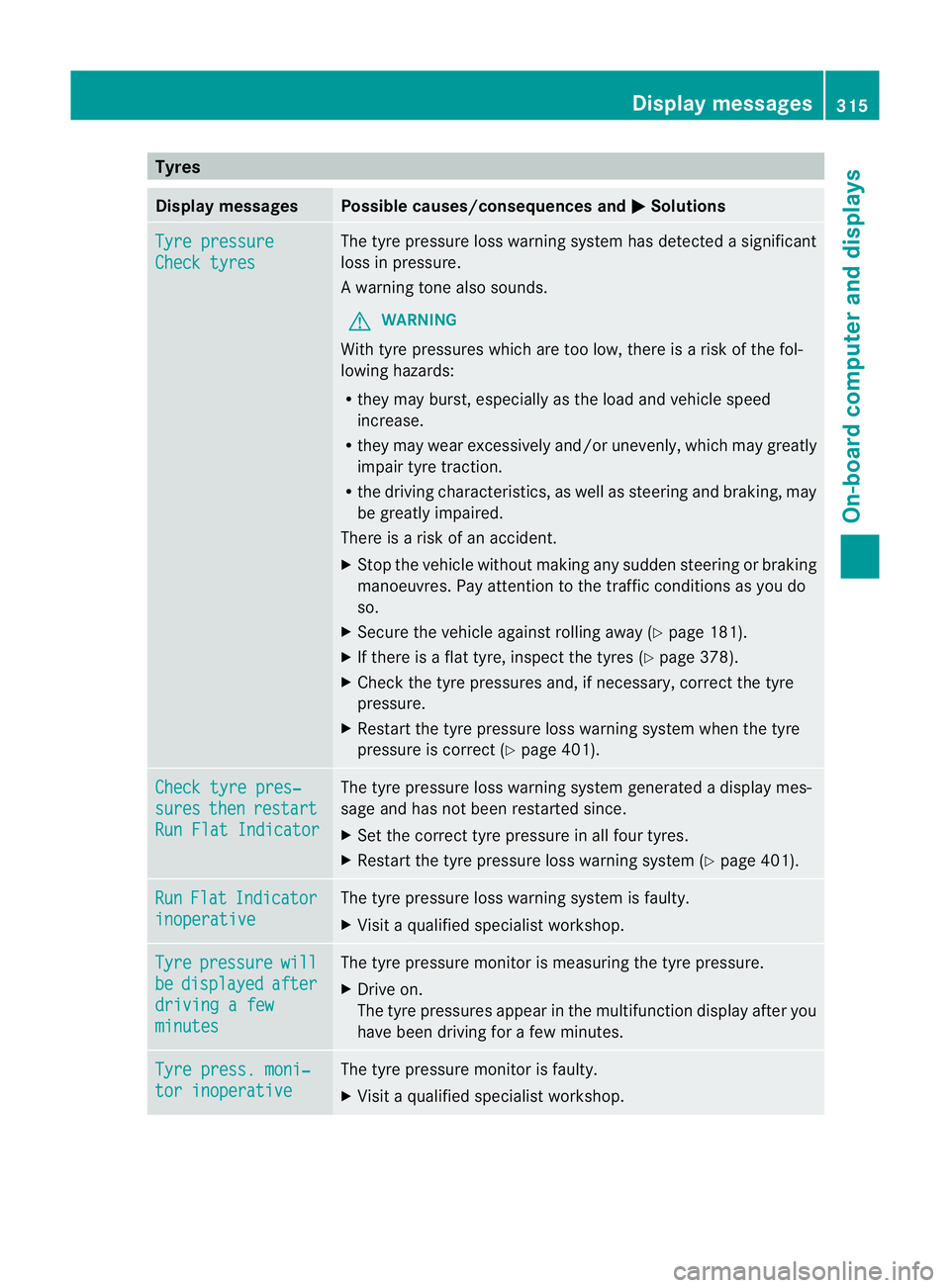
Tyres
Display messages Possible caus
es/consequences andM Solutions
Tyre pressure
Check tyres Th
et yre pressure loss warning system ha sdetected asignif icant
loss in pressure.
Aw arning ton ealso sounds.
G WARNING
Wit htyrep ressures which are too low, there is arisk of the fol-
lowing hazards:
R they ma yburst, especiall yasthe load and vehicle speed
increase.
R they ma ywear excessively and/or unevenly, which may greatly
impair tyr etraction.
R thed riving characteristics, as well as steering and braking, may
be greatl yimpaired.
There is arisk of an accident.
X Stop the vehicle without makin gany sudden steering or braking
manoeuvres .Pay attention to the traffic conditions as you do
so.
X Secure the vehicle against rolling away (Y page 181).
X If there is aflat tyre, inspect the tyres (Y page 378).
X Check the tyre pressures and, if necessary, correct the tyre
pressure.
X Restart the tyre pressure loss warnin gsystem when the tyre
pressure is correct (Y page 401).Check tyr
epres‐ sures then restart
Run Flat Indicator Th
et yre pressure los swarning system generated adispla ymes-
sage and has not been restarted since.
X Set the cor rect tyre pressure in all four tyres.
X Restart the tyre pressure los swarning system (Y page 401). Run Flat Indica
tor inoperative Th
et yre pressure los swarning system is faulty.
X Visit aqualified specialist workshop. Tyre pressu
re will
be displayed after
driving
afew minutes Th
et yre pressure monitor is measuring the tyre pressure.
X Driv eon.
The tyre pressures appear in the multifunction display after you
have bee ndriving for afew minutes. Tyre press. moni‐
to
ri noperative Th
et yre pressure monitor is faulty.
X Visit aqualified specialist workshop. Display messages
315On-board computer and displ ays Z
Page 319 of 441
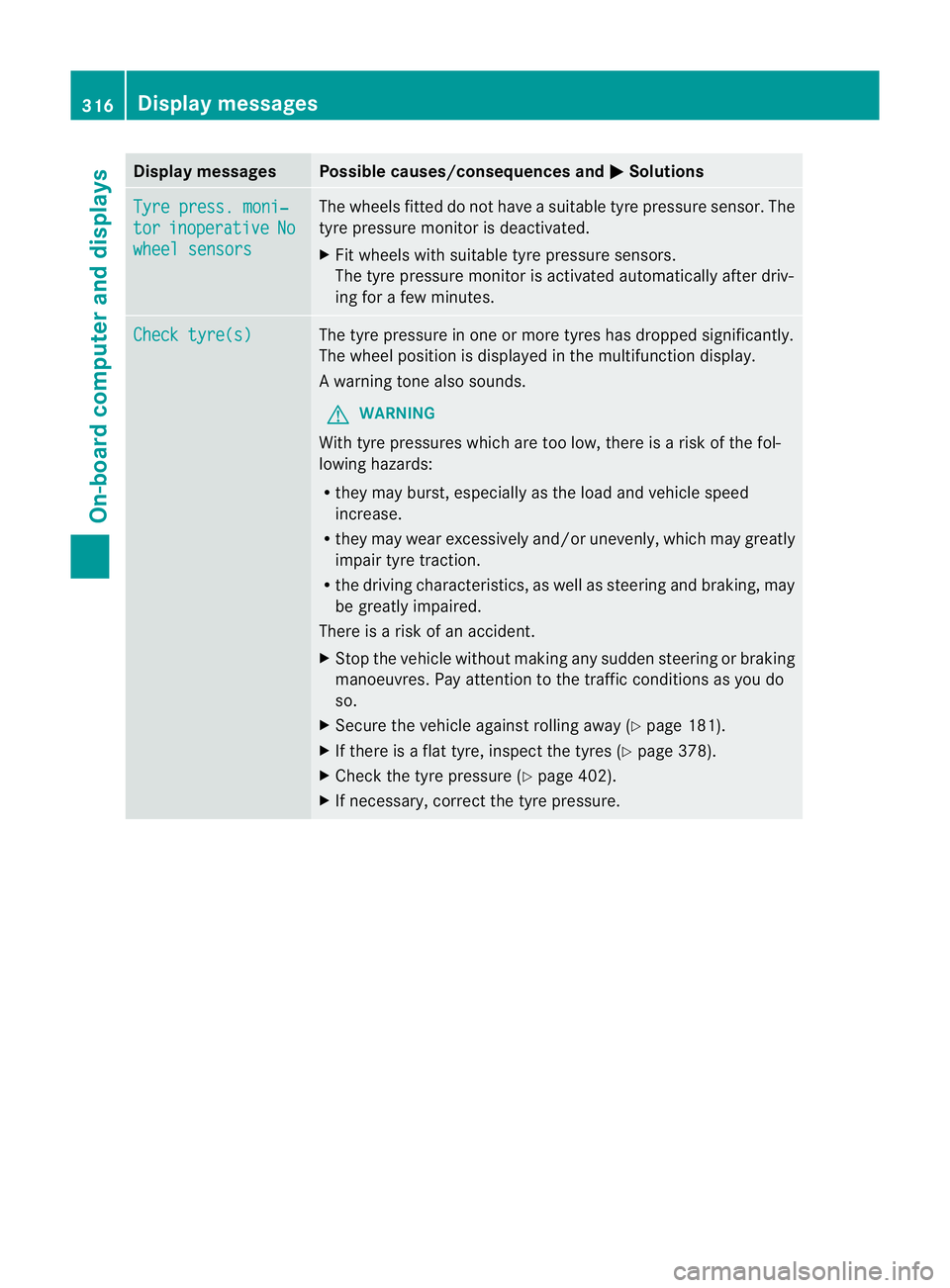
Displa
ymessages Possible causes/consequences and
M Solutions
Ty
re press. moni‐ tor inoperative No
wheel sensors Th
ew heels fitte ddonot have asuitable tyr epressure se nsor.T he
tyr ep ressure monito risd eactivated.
X Fit wheels with suitable tyr epressure sensors.
Th et yre pressure monitor is activated automatically after driv-
ing for afew minutes. Chec
ktyre(s) Th
et yre pressure in one or more tyres has droppe dsignificantly.
The wheel position is displayed in the multifunction display.
Aw arning ton ealso sounds.
G WARNING
Wit htyrep ressures which are too low, there is arisk of the fol-
lowing hazards:
R they ma yburst, especiall yasthe load and vehicle speed
increase.
R they ma ywear excessively and/or unevenly, which may greatly
impair tyr etraction.
R thed riving characteristics, as well as steering and braking, may
be greatl yimpaired.
There is arisk of an accident.
X Stop the vehicle without makin gany sudden steering or braking
manoeuvres .Pay attention to the traffic conditions as you do
so.
X Secure the vehicle against rolling away (Y page 181).
X If there is aflat tyre, inspect the tyres (Y page 378).
X Check the tyre pressure (Y page 402).
X If necessary, correct the tyre pressure. 316
Display messagesOn-board computer and displays
Page 321 of 441
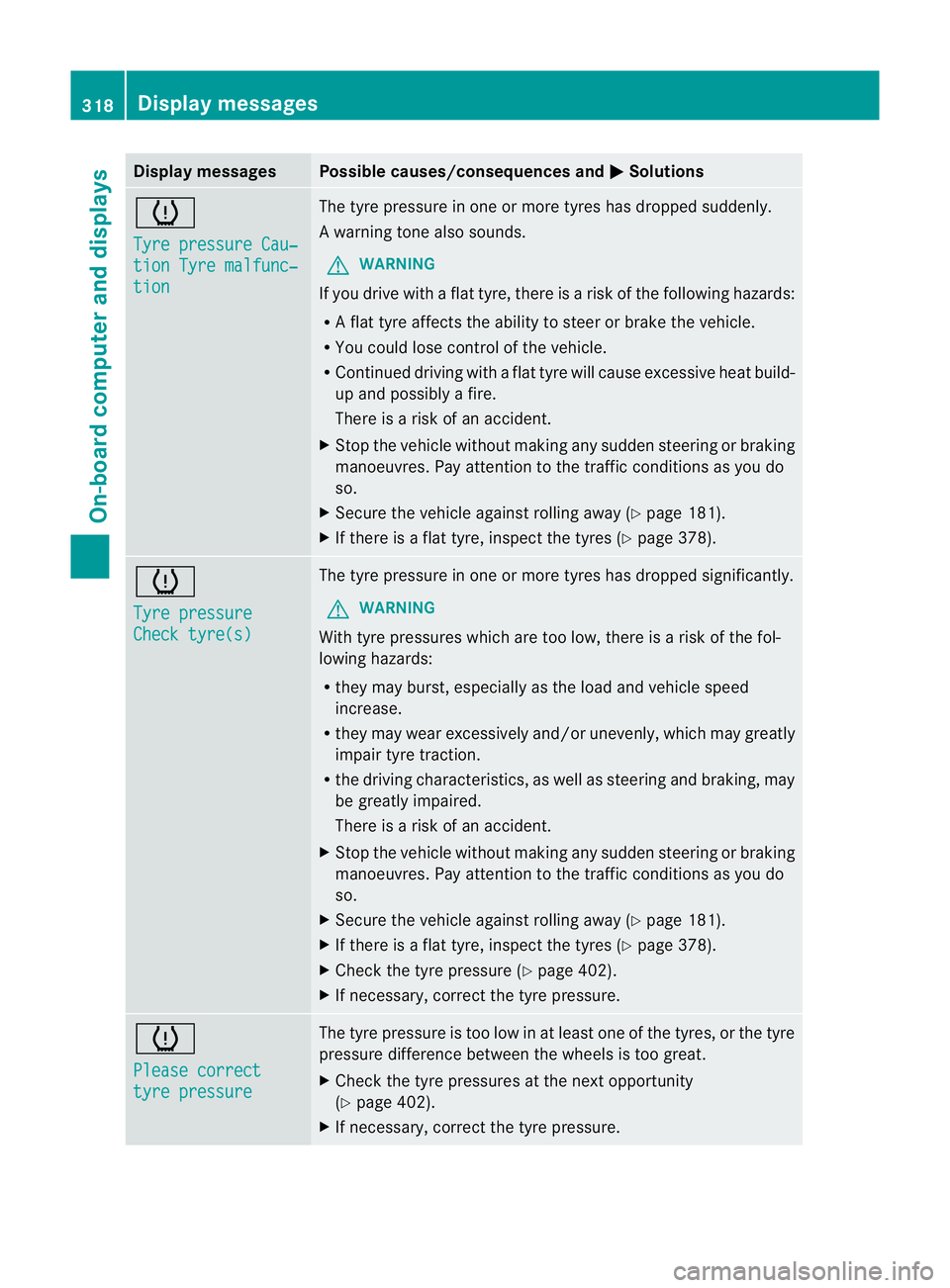
Displa
ymessages Possible causes/consequences and
M Solutions
h
Ty
re pressure Cau‐ tio
nT yrem alfunc‐ tion Th
et yrep ressur eino neor mor etyres has dropped suddenly.
Aw arning ton ealso sounds.
G WARNING
If you driv ewithaf lat tyre, there is arisk of the following hazards:
R Af lat tyre affects the ability to steer or brake the vehicle.
R You could lose control of the vehicle.
R Continued drivin gwithaflat tyre will cause excessive heat build-
up and possibly afire.
There is arisk of an accident.
X Stop the vehicle without makin gany sudden steering or braking
manoeuvres .Pay attention to the traffic conditions as you do
so.
X Secure the vehicle against rolling away (Y page 181).
X If there is aflat tyre, inspect the tyres (Y page 378).h
Tyre pressure
Chec
ktyre(s) Th
et yre pressure in one or more tyres has droppe dsignificantly.
G WARNING
With tyre pressures which are too low, there is arisk of the fol-
lowing hazards:
R they may burst, especiall yasthe load and vehicle speed
increase.
R they ma ywear excessively and/or unevenly, which may greatly
impair tyr etraction.
R thed riving characteristics, as well as steering and braking, may
be greatl yimpaired.
There is arisk of an accident.
X Stop the vehicle without makin gany sudden steering or braking
manoeuvres .Pay attention to the traffic conditions as you do
so.
X Secure the vehicle against rolling away (Y page 181).
X If there is aflat tyre, inspect the tyres (Y page 378).
X Check the tyre pressure (Y page 402).
X If necessary, correct the tyre pressure. h
Please correct
tyre pressure The tyre pressure is too low in at least one of the tyres, or the tyre
pressure difference between the wheels is too great.
X
Check the tyre pressures at the next opportunity
(Y page 402).
X If necessary, correct the tyre pressure. 318
Display messagesOn-board computer and displays
Page 329 of 441
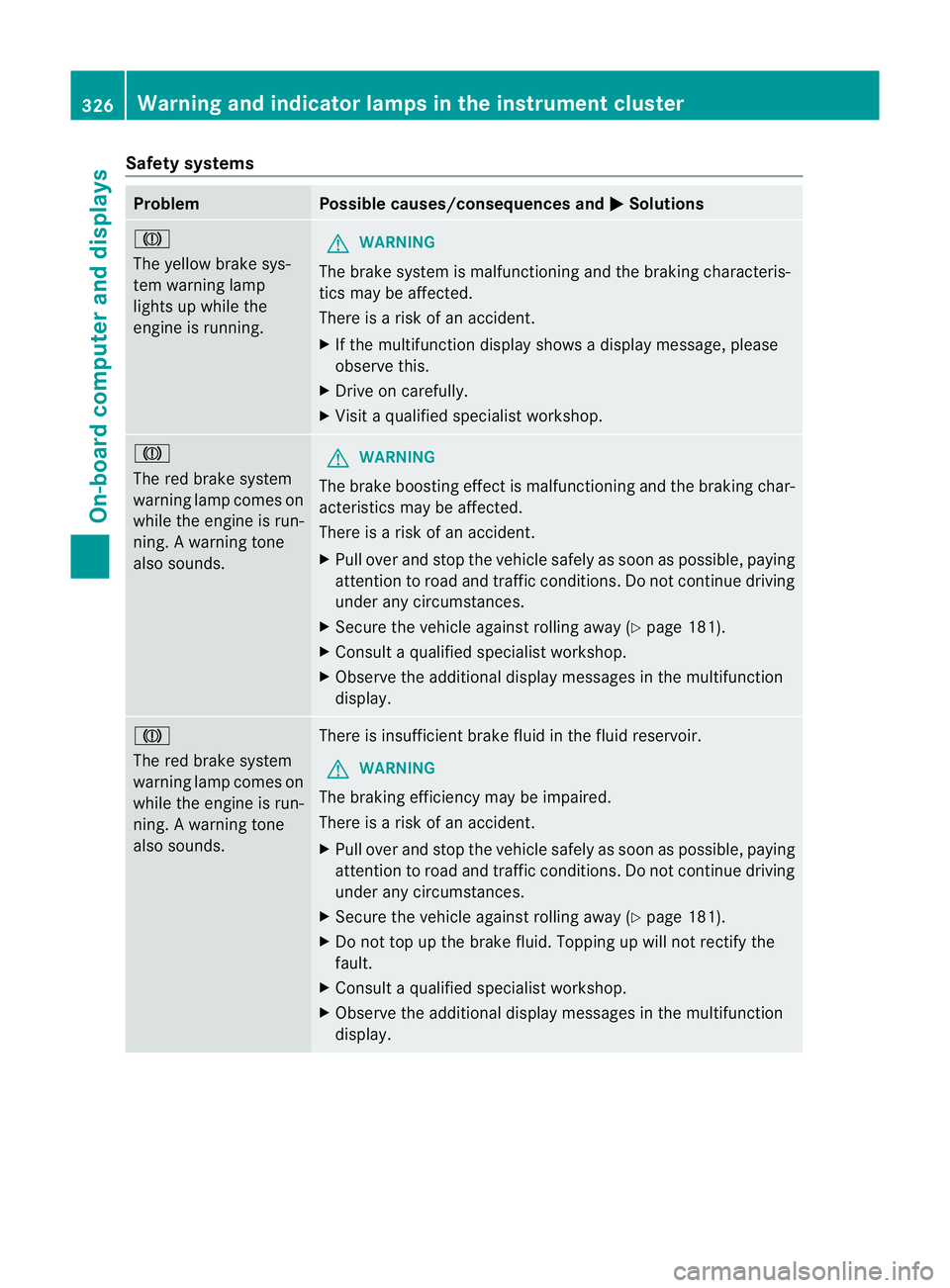
Safety systems
Problem Possible causes/consequences and
M Solutions
J
The yellow brake sys-
tem warnin glamp
lights up while the
engine is running. G
WARNING
The brake system is malfunctioning and the braking characteris-
tics may be affected.
There is arisk of an accident.
X If the multifunction display shows adisplay message, please
observe this.
X Driv eonc arefully.
X Visit aqualified specialist workshop. J
The red brake system
warning lamp comes on
while the engine is run-
ning. Awarning tone
also sounds. G
WARNING
The brake boosting effect is malfunctioning and the braking char-
acteristic smay be affected.
There is arisk of an accident.
X Pull over and stop the vehicle safely as soon as possible ,paying
attention to road and traffic conditions. Do not continue driving
under any circumstances.
X Secure the vehicle against rolling away (Y page 181).
X Consult aqualified specialist workshop.
X Observe the additional display messages in the multifunction
display. J
The red brake system
warning lamp comes on
while the engine is run-
ning. Awarning tone
also sounds. There is insufficient brake fluid in the fluid reservoir.
G WARNING
The braking efficienc ymay be impaired.
There is arisk of an accident.
X Pull over and stop the vehicle safely as soon as possible ,paying
attention to road and traffic conditions. Do not continue driving
under any circumstances.
X Secure the vehicle against rolling away (Y page 181).
X Do not top up the brake fluid. Topping up will not rectif ythe
fault.
X Consult aqualified specialist workshop.
X Observe the additional display messages in the multifunction
display. 326
Warnin
gand indicator lam psin th einstru ment clusterOn-board computer and displays
Page 337 of 441
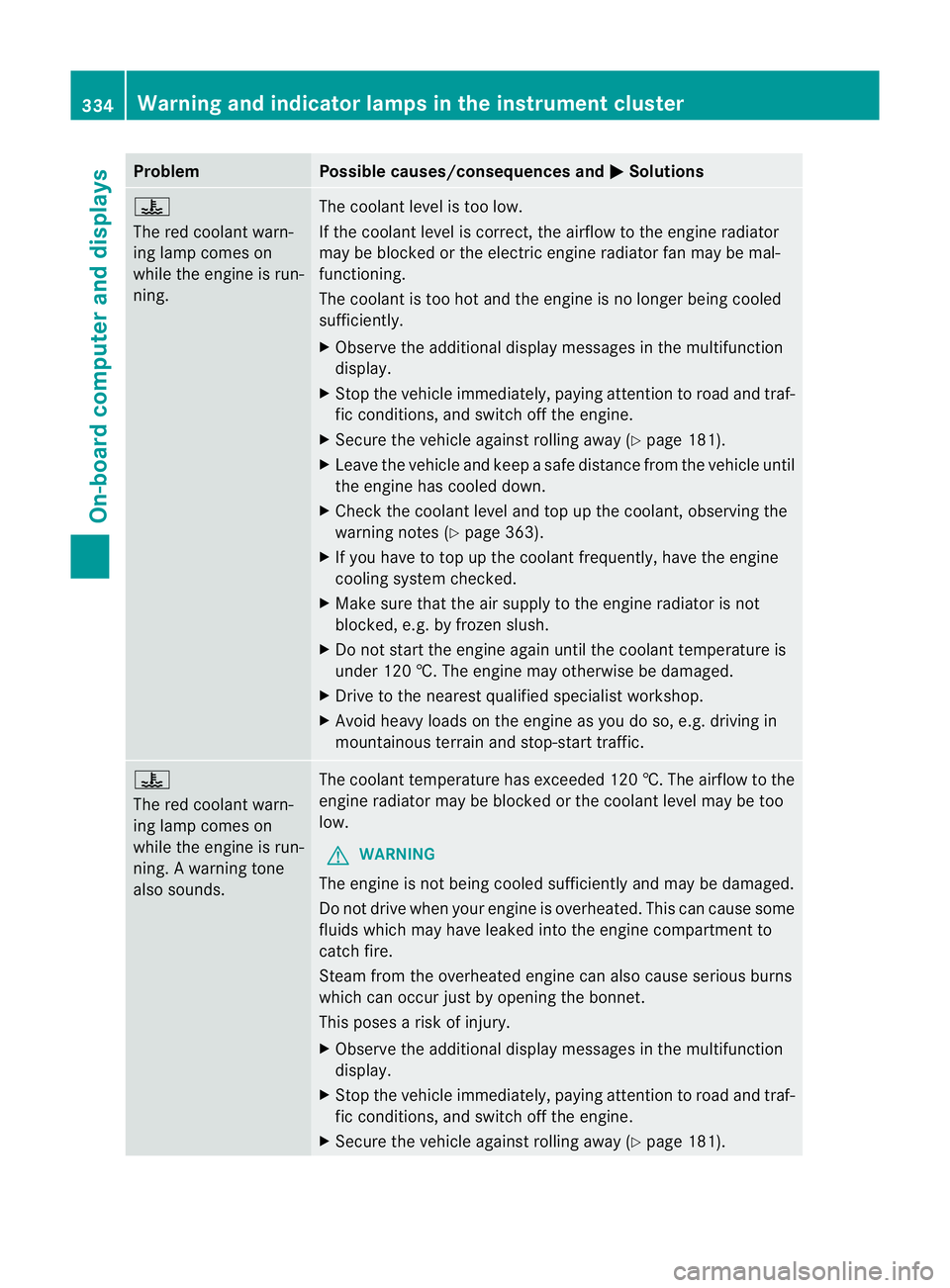
Problem Possible causes/consequences and
M Solutions
?
The red coolant warn-
ing lam
pcomes on
while the engin eisrun-
ning. The coolant level is too low.
If the coolant level is correct, the airflow to the engine radiator
may be blocked or the electric engine radiator fan may be mal-
functioning.
The coolant is too hot and the engine is no longer being cooled
sufficiently.
X
Observe the additional display messages in the multifunction
display.
X Stop the vehicle immediately, paying attention to road and traf-
fic conditions, and switch off the engine.
X Secure the vehicle against rolling away (Y page 181).
X Leave the vehicle and keep asafe distance from the vehicle until
the engine has cooled down.
X Check the coolant level and top up the coolant, observing the
warning notes (Y page 363).
X If you have to top up the coolant frequently, have the engine
cooling system checked.
X Make sure that the air supply to the engine radiator is not
blocked, e.g. by frozen slush.
X Do not start the engine again until the coolant temperature is
under 120 †. The engine may otherwise be damaged.
X Drive to the nearest qualified specialis tworkshop.
X Avoid heav yloads on the engin easyou do so, e.g. driving in
mountainous terrain and stop-star ttraffic. ?
Th
er ed coolan twarn-
ing lamp comes on
while the engine is run-
ning. Awarning tone
also sounds. The coolant temperature has exceeded 120 †. The airflow to the
engine radiator may be blocked or the coolant level may be too
low.
G WARNING
The engine is not being cooled sufficiently and may be damaged.
Do not drive when your engine is overheated. This can cause some
fluids which may have leaked into the engine compartmen tto
catch fire.
Stea mfrom th eoverh eated engine can als ocaus eserious burns
which can occu rjust by opening the bonnet.
This pose sarisk of injury.
X Observe the additional display messages in the multifunction
display.
X Stop the vehicle immediately, paying attention to road and traf-
fic conditions, and switch off the engine.
X Secur ethe vehicle against rolling away (Y page 181).334
Warning and indicator lamps in th
einstru ment clusterOn-board computer and displays
Page 339 of 441
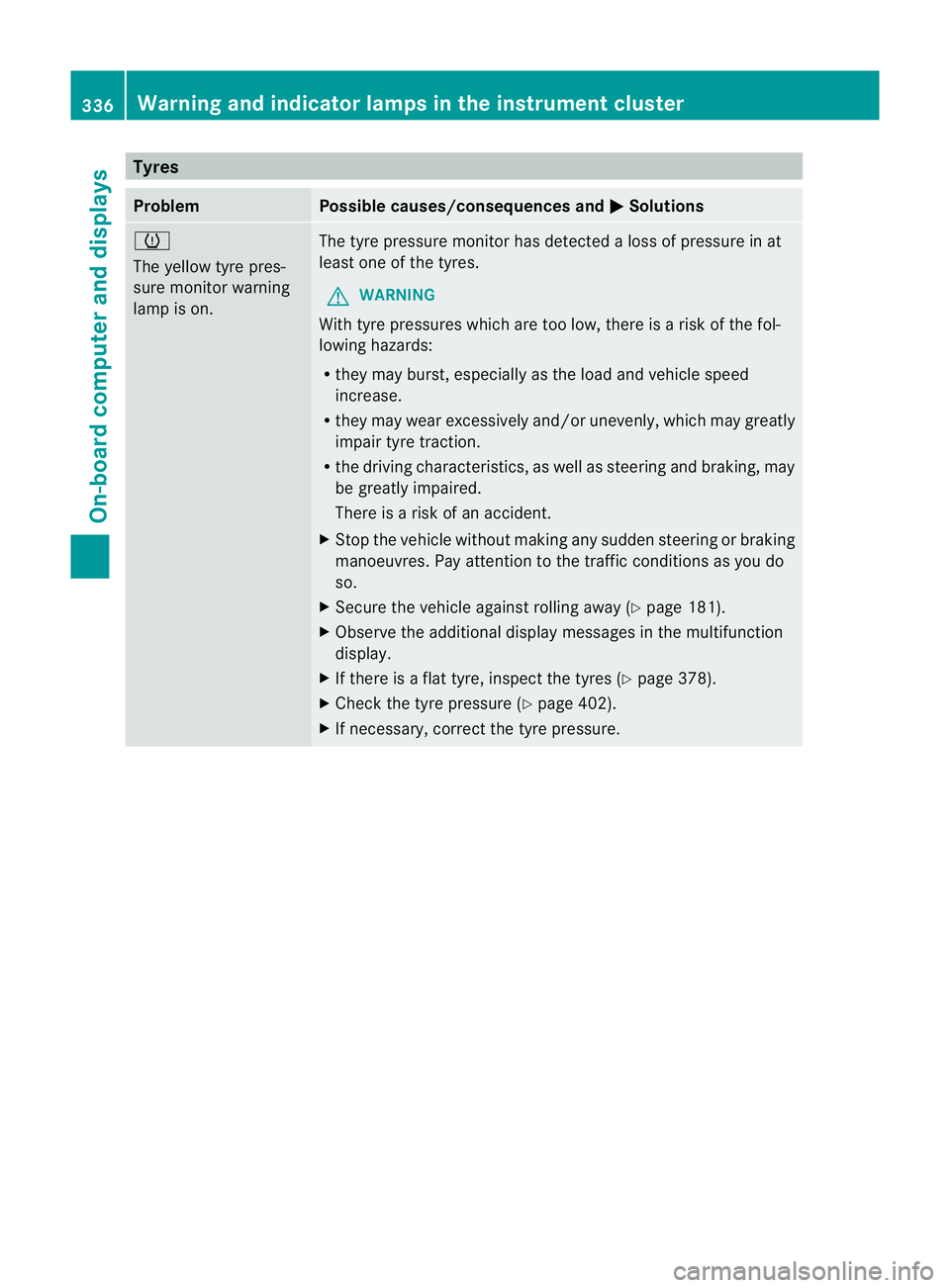
Tyres
Problem Possible caus
es/consequences andM Solutions
h
Th
ey ello wtyre pres-
sure monitor warning
lamp is on. The tyre pressure monitor ha
sdetected alossofp ressureinat
leas tone of the tyres.
G WARNING
With tyre press ures which are too low, there is ariskoft he fol-
lowin ghazards:
R they may burst, especiall yasthe load and vehicle speed
increase.
R they ma ywear excessively and/or unevenly, which may greatly
impair tyr etraction.
R thed riving characteristics, as well as steering and braking, may
be greatl yimpaired.
There is arisk of an accident.
X Stop the vehicle without makin gany sudden steering or braking
manoeuvres .Pay attention to the traffic conditions as you do
so.
X Secure the vehicle against rolling away (Y page 181).
X Observe the additional displ aymessage sint he multifunction
display.
X If ther eisaflat tyre ,inspect the tyres (Y page378).
X Check the tyre pressure (Y page402).
X If necessary, correct the tyre pressure. 336
Warnin
gand indicator lam psin th einstru ment clusterOn-board computer and displays
Page 350 of 441
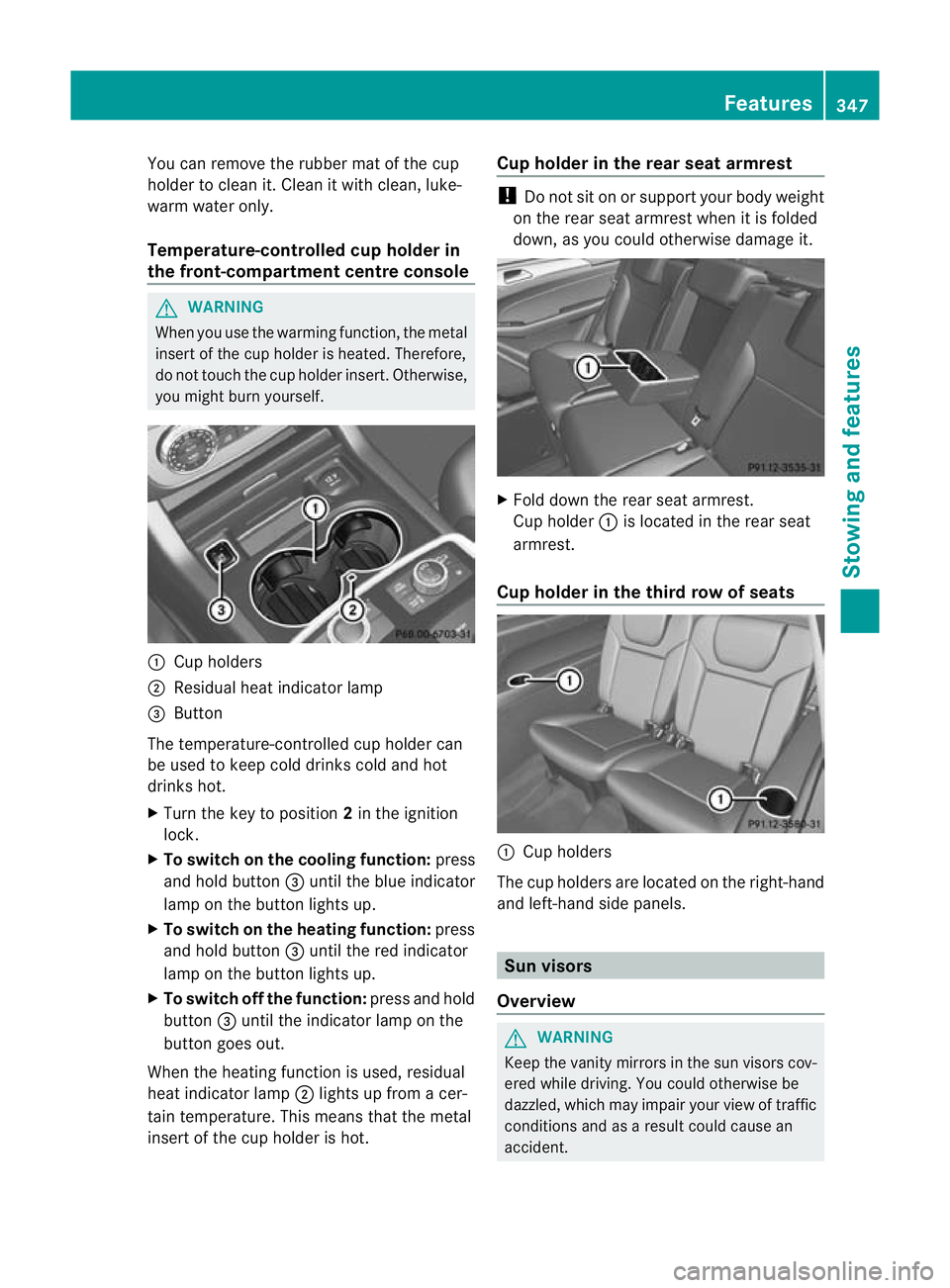
You can remove the rubber mat of the cup
holder to clean it. Clean it with clean
,luke-
warm water only.
Temperature-controlled cup holder in
th ef ront-compartment centr econsole G
WARNING
When you use the warmin gfunction ,the metal
insert of thecup holder is heated. Therefore,
do not touch the cup holder inser t.Otherwise,
you migh tburny oursel f. :
Cuph olders
; Residual heat indicator lamp
= Button
Th et emperature-c ontrolle dcup holde rcan
be used to keep cold drinks cold and hot
drinks hot.
X Turn the key to position 2in the ignition
lock.
X To switch on th ecooling function: press
and hold button =until th eblue indicator
lamp on th ebutton lights up.
X To switch on th eheating function: press
and hold button =until the red indicator
lamp on the button lights up.
X To switch off th efunc tion: press and hold
button =until the indicator lamp on the
button goes out.
When the heatin gfunction is used, residual
heat indicator lamp ;lights up fro macer-
tain temperature. This mean sthat the metal
insert of the cup holder is hot. Cu
ph older in th erears eat armrest !
Do not sit on or support your body weight
on the rear seat arm rest when it is folded
down ,asy ou coul dotherwise damage it. X
Fold down the rear seat armrest.
Cup holder :is located in the rear seat
armrest.
Cup holder in th ethird row of seats :
Cup holders
The cup holders are located on the right-hand
and left-han dside panels. Sun visors
Overview G
WAR
NING
Keep the vanity mirrors in the sun visors cov-
ered whil edriving.Y ou coul dotherwise be
dazzled, which may impair your view of traffic
conditions and as aresult could cause an
accident. Features
347Stowing and features Z
Page 368 of 441
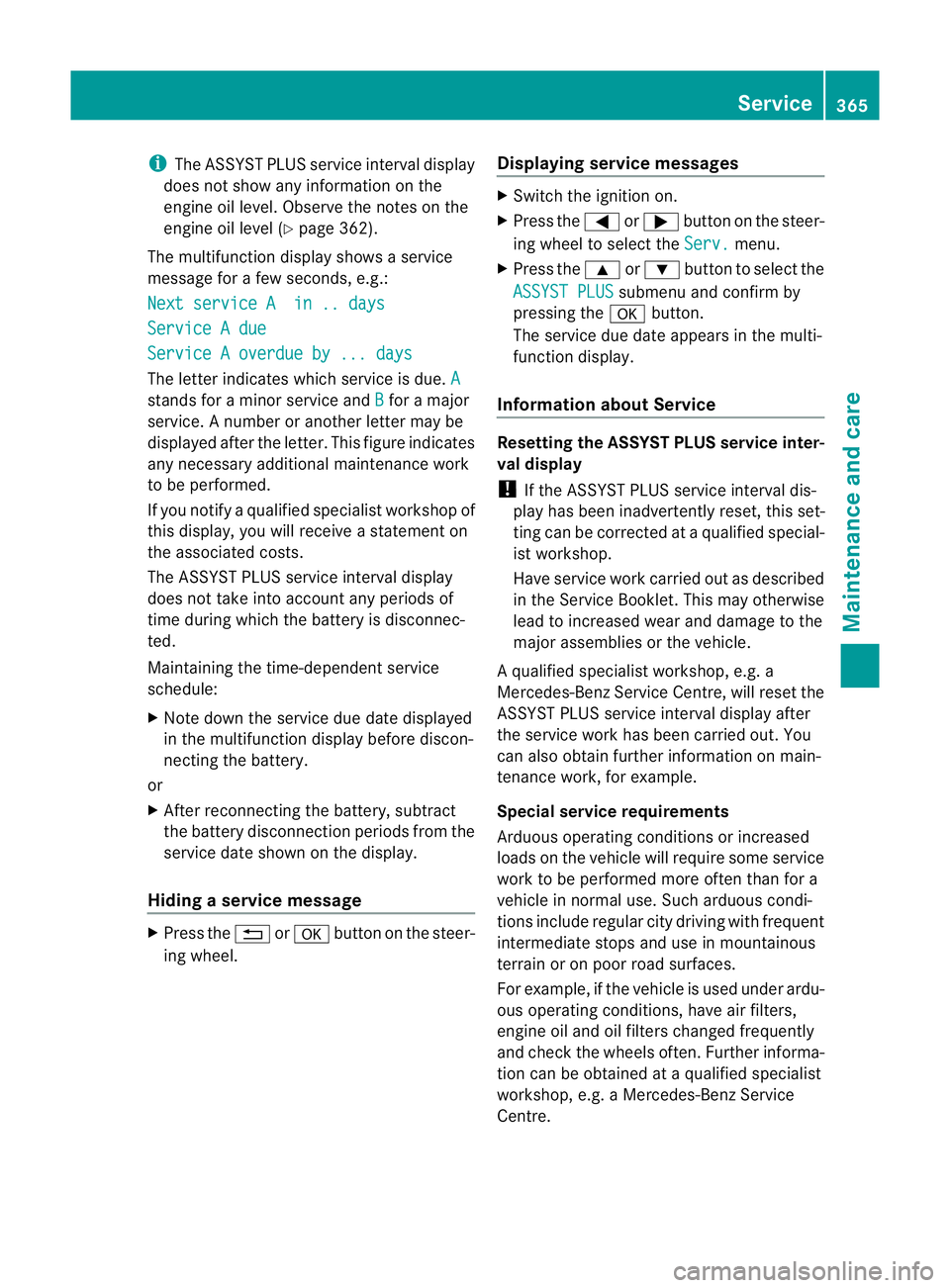
i
The ASSYST PLU Sservice interval display
does not show any information on the
engine oil level. Observ ethe notes on the
engin eoil level (Y page 362).
The multifunction display shows aservice
message for afew seconds, e.g.:
Next servic eAin .. days Service
Adue Service
Aoverdue by ... days Th
eletter indicates which service is due. Astands for
aminor servic eand B for
am ajor
service. Anumber or another letter may be
displayed after the letter. This figure indicates
any necessary additional maintenanc ework
to be performed.
If you notify aqualified specialist worksho pof
this display, you will receive astatement on
the associated costs.
The ASSYST PLUS service interval display
doe snot tak einto account any periods of
tim eduring which the battery is disconnec-
ted.
Maintaining the time-dependent service
schedule:
X Note down the service du edated isplayed
in the multifunction displa ybefor ediscon-
nectin gthe battery.
or
X After reconnecting the battery ,subtract
the battery disconnection periods fro mthe
service date shown on the display.
Hiding aservice message X
Pres sthe % ora button on th esteer-
ing wheel. Displaying service messages X
Switch th eignitio non.
X Press the =or; button on the steer-
ing whee ltoselect the Serv. men
u.
X Press the 9or: button to select the
ASSYS TPLUS submenu and confirm by
press ingt he a button.
The service due date appears in the multi-
function display.
Informatio nabout Service Resetting th
eASSYST PLUS service inte r-
val display
! If the ASSYS TPLUS service interva ldis-
play has been inadvertently reset ,this set-
tin gc an be corrected at aqualified special-
ist workshop.
Have service work carried out as described
in the Servic eBooklet. This ma yotherwise
lead to increased wear and damage to the
major assemblies or the vehicle.
Aq ualified specialist workshop, e.g. a
Mercedes-Ben zService Cent re,w ill reset the
ASSYST PLU Sservic einterval display after
the service work has bee ncarried out. You
can also obtain further information on main-
tenance work, for example.
Special service requirements
Arduous operating conditions or increased
loads on the vehicle will require some service
work to be performed more often than for a
vehicle in normal use. Such arduous condi-
tions include regular city driving with frequent
intermediate stops and use in mountainous
terrain or on poor road surfaces.
For example, if the vehicle is used under ardu-
ous operating conditions, have air filters,
engine oil and oil filters changed frequently
and check the wheels often .Further informa-
tion can be obtaine dataqualified specialist
workshop, e.g. aMercedes-Ben zService
Cent re. Service
365Maintenance and care Z
Page 402 of 441
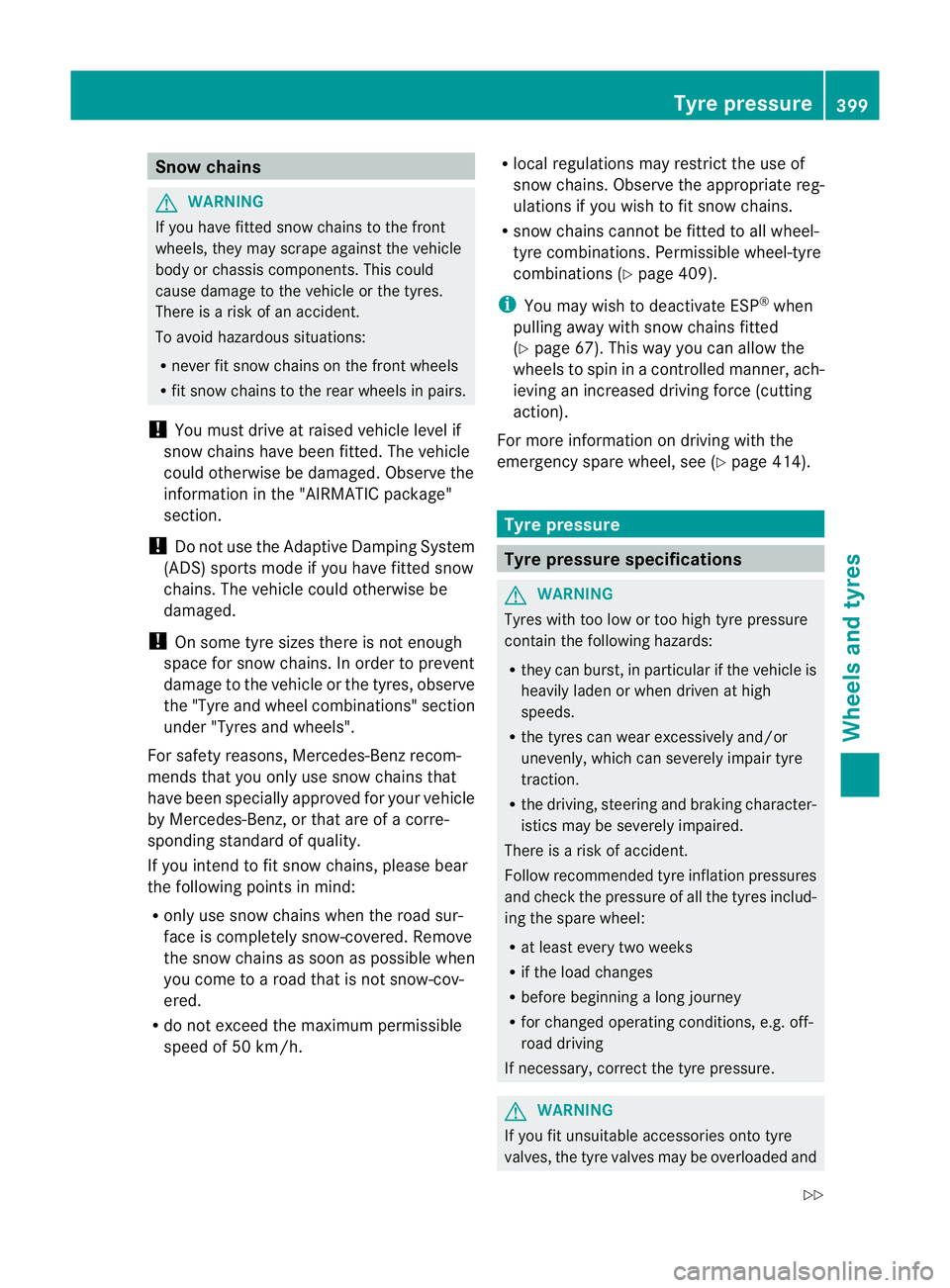
Snow chains
G
WARNING
If you hav efitted snow chains to the front
wheels, they may scrape against the vehicle
body or chassis components. This could
cause damage to the vehicle or the tyres.
There is arisk of an accident.
To avoid hazardous situations:
R never fit snow chains on the fron twheels
R fit snow chains to the rea rwheels in pairs.
! You must driv eatraised vehicle level if
snow chains have been fitted. The vehicle
could otherwise be damaged. Observe the
information in the "AIRMATIC package"
section.
! Do not use the Adaptive Damping System
(ADS )sports mode if you have fit teds now
chains .The vehicle could otherwise be
damaged.
! On some tyr esizes there is not enough
space for snow chains. In order to prevent
damage to the vehicle or the tyres, observe
the "Tyre and wheel combinations" section
under "Tyres and wheels".
For safety reasons, Mercedes-Benz recom-
mends that you only use snow chains that
have been specially approved for your vehicle
by Mercedes-Benz, or that are of acorre-
spondin gstandard of quality.
If you intend to fit snow chains ,please bear
the following points in mind:
R only use snow chains when the road sur-
face is completely snow-covered. Remove
the snow chains as soon as possible when
you come to aroad that is not snow- cov-
ered.
R do not exceed the maximu mpermissible
speed of 50 km /h. R
local regulations may restric tthe use of
snow chains. Observ ethe appropriate reg-
ulations if you wish to fit snow chains.
R snow chains cannot be fitted to all wheel-
tyr ec ombinations. Permissible wheel-tyre
combination s(Ypage 409).
i You may wish to deactivat eESP®
when
pull inga way with snow chains fitted
(Y page 67). This way you can allow the
wheels to spin in acontrolled manner ,ach-
ieving an increased driving force (cutting
action).
For more information on driving with the
emergency spare wheel, se e(Ypage 414). Ty
re pr essure Tyr
epressure specifications G
WARNING
Tyres with too low or too high tyre pressure
contain the following hazards:
R they can burst, in particular if the vehicle is
heavily laden or when driven at high
speeds.
R the tyres can wear excessively and/or
unevenly, which can severely impair tyre
traction.
R the driving, steering and braking character-
istics may be severely impaired.
There is arisk of accident.
Follow recommended tyre inflation pressures
and check the pressure of all the tyres includ-
ing the spare wheel:
R at least every two weeks
R if the load changes
R before beginning along journey
R for changed operatin gconditions, e.g. off-
road driving
If necessary ,correct the tyr epressure. G
WARNING
If you fit unsuitabl eaccessories onto tyre
valves ,the tyr evalves may be overloaded and Tyr
epressure
399Wheels and ty res
Z
Page 403 of 441
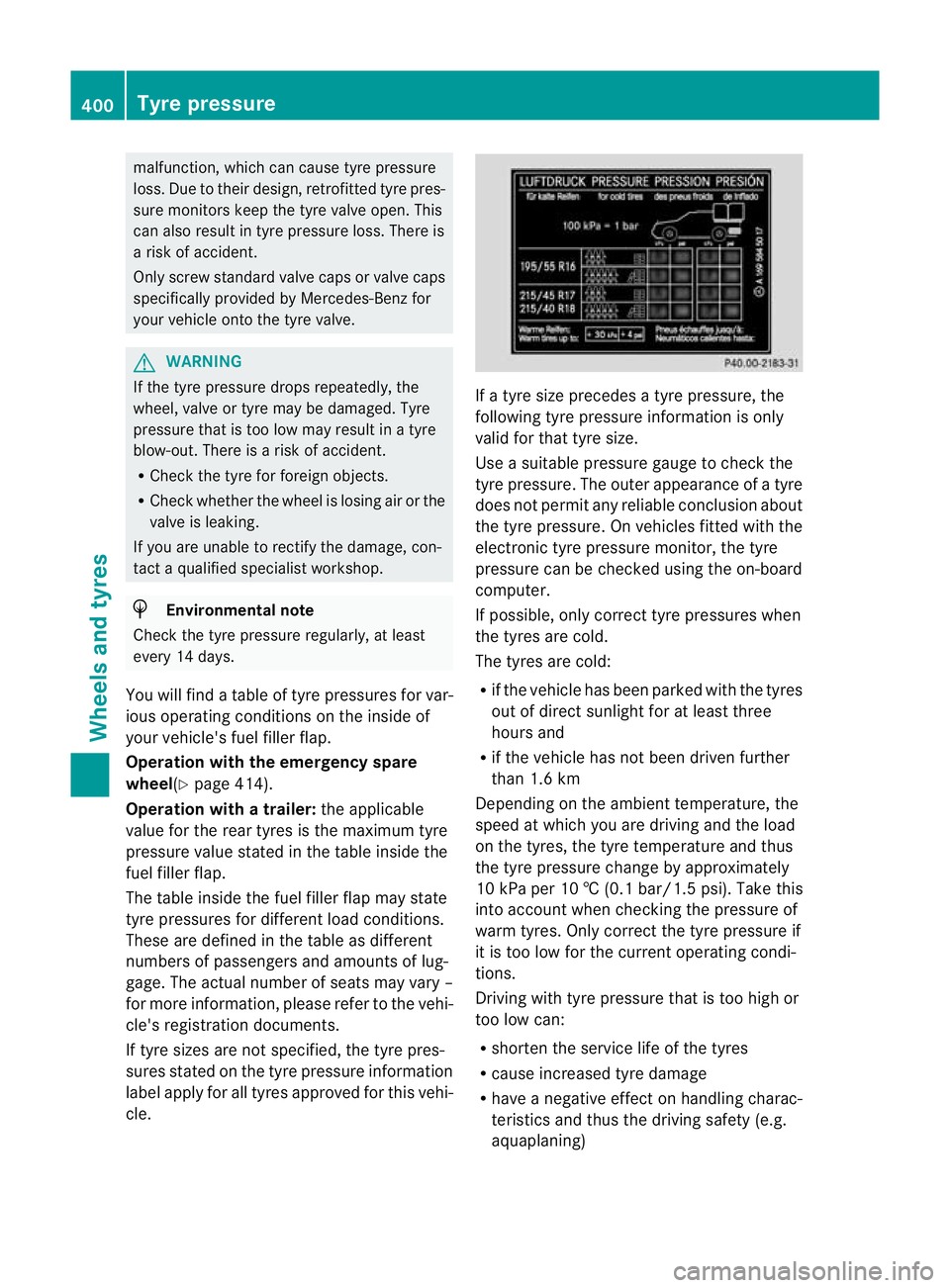
malfunction, which can caus
etyre press ure
loss. Due to their design, retrofitted tyre pres-
sure monitor skeep the tyr evalve open. This
can als oresul tint yre pressur eloss .There is
ar isk of accident.
Only screw standard valv ecaps or valve caps
specifically provided by Mercedes-Benz for
your vehicle onto the tyre valve. G
WARNING
If the tyre pressure drops repeatedly, the
wheel, valve or tyre may be damaged. Tyre
pressure that is too low may result in atyre
blow-out. There is arisk of accident.
R Check the tyre for foreign objects.
R Check whether the wheel is losing air or the
valv eisl eaking.
If you are unabl etorectify the damage, con-
tac ta qualified specialist workshop. H
Environmental note
Check the tyr epressure regularly, at least
every 14 days.
Yo uw ill find atable of tyre pressures for var-
ious operating conditions on the inside of
your vehicle's fuel filler flap.
Operation with the emergency spare
wheel(Y page 414).
Operation with atrai ler: the applicable
value for the rear tyres is the maximum tyre
pressure value stated in the table inside the
fuel filler flap.
The table inside the fuel filler flap may state
tyr ep ressures for different load conditions.
Thes eare define dinthe tabl easdifferent
number sofpassengers and amounts of lug-
gage. The actual number of seats may vary –
for more information, please refer to the vehi-
cle's registration documents.
If tyre sizes are not specified, the tyre pres-
sures stated on the tyre pressure information
label apply for all tyres approved for this vehi-
cle. If
at yre size precede satyre pressure, the
following tyre pressure information is only
valid for that tyre size.
Use asuitable pressure gauge to check the
tyre pressure. The outer appearance of atyre
doe snot permit any reliable con clusion about
the tyre pressure. On vehicles fitted with the
electronic tyre pressure monitor, the tyre
pressure can be checked using the on-board
computer.
If possible, only correc ttyre pressures when
the tyres are cold.
The tyres are cold:
R if the vehicl ehas been parked wit hthe tyres
out of direc tsunlight for at least three
hours and
R if the vehicle has not been driven further
than 1. 6km
Depe nding on the ambient temperature, the
speed at which you are drivin gand the load
on the tyres, the tyre temperature and thus
the tyre pressure chang ebyapproximately
10 kPa per 10 †(0.1 ba r/1.5 ps i).T ake this
into account whe nchecking the pressur eof
warm tyres. Only correc tthe tyr epressure if
it is to olow for the curren toperating condi-
tions.
Drivin gwith tyre pressure that is too high or
too low can:
R shorten the servic elife of the tyres
R cause increased tyre damage
R have anegativ eeffect on handling charac-
teristics and thus th edriving safet y(e.g.
aquaplaning) 400
Ty
re pressureWheel sand ty res